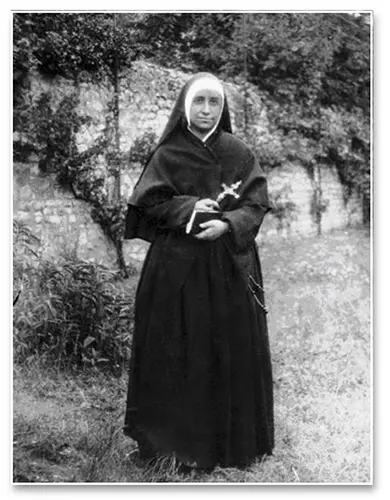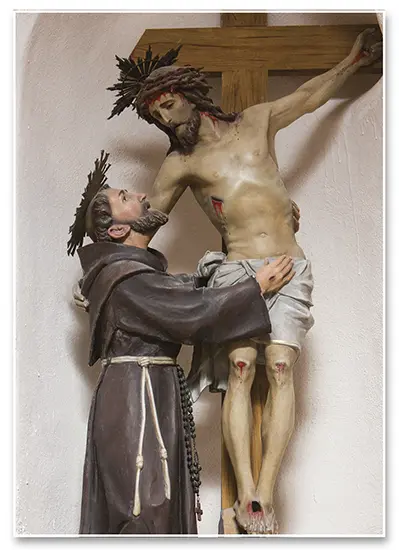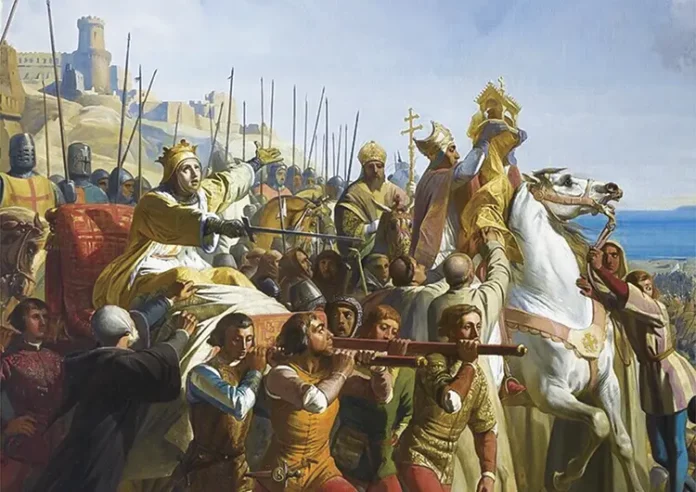It was 1177. Before the Battle of Montgisard, the sublime gesture of a certain king comforted Our Lord Jesus Christ and obtained the victory for the Christians.
When the enemy army came into view, Baldwin IV did not fear in the face of the terrible and obvious disproportion of forces: one crusader to more than a hundred Mohammedans. He was only sixteen years old, and at that young age he was already consumed by leprosy. He dismounted from his horse and prostrated himself with his face to the ground, at the foot of the relic of the true Cross that preceded his warriors, to implore the Saviour’s protection. When he arose, everyone saw that his face, swollen by the disease, was bathed in tears.1
On learning of this fact, Dr. Plinio Corrêa de Oliveira commented: “Our Lord Jesus Christ, nailed to the Cross, had full knowledge of the future. And in the midst of the countless sorrows that this future caused Him, He knew what was to be the destination of each fragment of that Cross that He was making sacred by His Sacrifice. […] The Divine ‘Leper’ […] foresaw that one of the fragments of that Cross would be adored by a leprous son in the desert. […] He saw that man’s ‘angelic’ adoration and was consoled. […] Baldwin drew something akin to a smile from the poor ‘leprous’ lips of Our Lord as He expired.”2
Let us leave this poignant scene at a standstill and turn our attention to another one – no longer on an arena of war, but on a different battlefield: that of a monastery.
Sister Josefa Menéndez, who lived in the late 19th and early 20th centuries, was a soul favoured by frequent visions of Our Lord. On one of these occasions, He showed the seer His Divine Heart with three new wounds, and explained that He had come to ask her, through sacrifices and prayers, to give Him back three priests who had abandoned Him. The nun spent days immersed in great suffering and offered everything to win back those souls.3
If we meditate a little on these two episodes, some questions are bound to arise in our souls, such as whether the sufferings endured by the God-Man were insufficient, in such a way so that He would need collaborators throughout history to complete His redemptive Sacrifice. And can we really console Him in His Passion, even though we live centuries after His Ascension into Heaven?

Sister Josefa Menéndez
Called to be co-redemptors
When we look at the lives of the saints, we can see how the Kingdom of Heaven is populated by men and women of all races, nations, languages and ages. During their life on this earth they were nobles or humble servants; some of them endowed with unspeakable wisdom, others almost ignorant. The magnificent garden of the Lord, in the beautiful expression of St. Augustine,4 is composed not only of the roses of the martyrs, but also the lilies of the virgins, the ivy of married persons, the violet of the widows; and in this diversity we find a common denominator that no blessed person lacked: a love of suffering.
Each in their own time, according to their state, their vocation, their charisms and gifts, followed Our Lord’s command with complete fidelity: “If any man would come after Me, let him deny himself and take up his cross daily and follow Me” (Lk 9:23). And now they can be recognized by the illustrious title of co-redemptor.
Co-redemptor? Yes – it is no exaggeration! – and this does not just apply to those who are already part of the Church Glorious, but it is an invitation to each and every one of us. In his work Jesucristo y la vida cristiana, Fr. Royo Marín5 discusses this topic with his characteristic clarity and simplicity, as we will see below.
The priesthood of every baptized person requires sacrifice
The essential act of every priest is sacrifice. Our Lord Jesus Christ, the High and Eternal Priest, exercised it by immolating Himself on the altar of the Cross; His ministers, priests by participating in His priesthood through the Sacrament of Holy Orders, fulfil this function primarily in the Eucharistic Celebration, which is the unbloody renewal of the Sacrifice of Calvary. And how does this happen with the rest of the faithful who, in some way, also share in Christ’s priesthood through Baptism?
Just as God entrusted mankind with the mission of completing the beauties of creation, without this allowing us to conclude that they were poorly made, He also desires that the baptized, through their sufferings, complete the saving mission of the Incarnate Word, according to the words of St. Paul: “in my flesh I complete what is lacking in Christ’s afflictions for the sake of His Body, that is, the Church” (Col 1:24).
The Passion of Our Lord Jesus Christ has infinite merits and is entirely sufficient to redeem the whole human race. In this respect, no one can add anything to it. But out of unspeakable goodness, the Saviour “wills to be helped […] in carrying out the work of Redemption”6 and He therefore invites the baptized to pay a portion of this ransom.
“In my flesh I complete”
This completion of the Passion can happen in two ways:
Firstly, by applying the merits of the Passion. Our Lord entrusted the immense treasure of the Redemption to the Church, and to distribute it He wants not only His Divine Bride’s participation, but also the contribution of the baptized: “the salvation of many depends on the prayers and voluntary penances that the members of the Mystical Body of Jesus Christ offer for this intention.”7
Moreover, through the sufferings of the members of the Mystical Body themselves. When Jesus offered Himself as a victim on Calvary, He did so as the Head of His Mystical Body, presenting all the other members to the Father, and for this reason His Passion continues in them throughout the ages. “He contemplated us at every moment of our lives; He knew our actions, our resolutions, our faults, our prayers. Nothing escaped His gaze. […] Jesus Christ, our adorable Head, was consoled and sustained by the sight of all His members, who over the centuries would collaborate in His sufferings. In this intimacy of thought with all of us, He suffered His horrendous martyrdom. […] For God, before whom everything appears as an eternal present, the homage of the holy Victim was compounded by all the atonements of the future.”8
No suffering has sanctifying power on its own. On Calvary, in addition to the Redeemer, there were two other condemned men, and we know the blasphemous attitude displayed by the bad thief (cf. Lk 23:39). If we look around us, we see suffering everywhere, but this does not mean that the world is full of saints. The only pain capable of sanctifying is that borne patiently out of love for God and in union with the infinite merits of Our Lord. Unfortunately, countless souls are unaware of the value and sublimity of pain faced in this way!
“For the sake of His Body, that is, the Church”
In the natural body, each part aims at the well-being of the whole; in the Holy Church, in a similar and more sublime way, there is also a mutual dependence among the members. This is what is known as the Communion of Saints: the merit acquired by one member enriches the whole Church and, contrario sensu, every grace that is impeded in some part of this Mystical Body affects it as a whole.
God gives everyone the necessary means to reach Heaven. However, He often makes the superabundant graces – which give these means their effectiveness – conditional on the co-operation of the merits of others.9 In this sense, we can be an occasion of grace for others, but we must also be open to the graces that God wants to grant us through the intercessors that He Himself places in our path.
It is also for this reason that the acts and, above all, the sufferings of each baptized person, when offered in union with the infinite merits of Christ’s Passion, can have expiatory value for their own sins and co-redemptive value to assist the other members of the Mystical Body. And it is in this way that one can truly console Our Lord in His sufferings and help Him in the salvation of souls.

Christ crucified and St. Francis of Assisi – Milk Grotto, Bethlehem (Israel)
The apostolate to which we are all called
Thus, we have in our hands a real weapon of conquest! Let us be sure to use it well! At Holy Mass, the priest pours a drop of water into the chalice of wine, as required by the rubrics. Among other symbolisms, this drop represents human suffering united to that of the God-Man. And to this apostolate we are all called! Therefore let us be generous and unite our sufferings, together with Our Lady’s tears, to the Most Precious Blood of Jesus, so that the Passion can be fully effective for souls.
To do this, we do not need to go in search of sufferings. Pain knocks at our doors all the time; we just have to accept it with peace of mind and take every opportunity to offer God the small sacrifices of daily life. In this sense, Dr. Plinio’s advice is precious:
“When, for example, I have an unpleasant and tedious task to do, and I do not feel like doing it, if it is my duty, I do it and with élan! […] But if I have a pleasant task to do, I should never give it preference: I should let the impetus pass first and do it later. […] Someone will say: ‘But, Dr. Plinio, that is such a small thing!’ I reply: ‘To do many small things like that is immense! And do them we must!’”10
Let us ask Our Lady, Virgo Fidelis, to make us faithful to the crosses that Providence sends us, carrying out our mission as co-redemptors with generosity. In this way, we will reciprocate the boundless love of which we were the object in the Passion, and we will contribute to the full realization of all its effects. ◊
Notes
1 Cf. BORDONOVE, Georges. Les Croisades et le Royaume de Jérusalem. Paris: Pygmalion Gérard Watelet, 2002, p.281.
2 CORRÊA DE OLIVEIRA, Plinio. Conference. São Paulo, 21/10/1972.
3 Cf. MENÉNDEZ, RSCJ, Josefa. Apelo ao amor. 3.ed. Rio de Janeiro: Editora Rio-São Paulo, 1963, p.166-183.
4 Cf. ST. AUGUSTINE. Sermo CCCIV, c.2: PL 38, 1396.
5 Cf. ROYO MARÍN, OP, Antonio. Jesucristo y la vida cristiana. Madrid: BAC, 1961, p.573-581.
6 PIUS XII. Mystici Corporis Christi, n.44.
7 Idem, ibidem.
8 GRIMAUD. Él y nosotros: un solo Cristo, apud ROYO MARÍN, op. cit., p.574.
9 Cf. PLUS, Raúl. Cristo en nuestros prójimos, apud ROYO MARÍN, op. cit., p.577.
10 CORRÊA DE OLIVEIRA, Plinio. Termômetro do verdadeiro fervor [Thermometer of True Fervour]. In: Dr. Plinio. São Paulo. Year XXVI. N.306 (Sept., 2023); p.31-32. See the transcript of the article in the section A Prophet for Our Times in this magazine.


